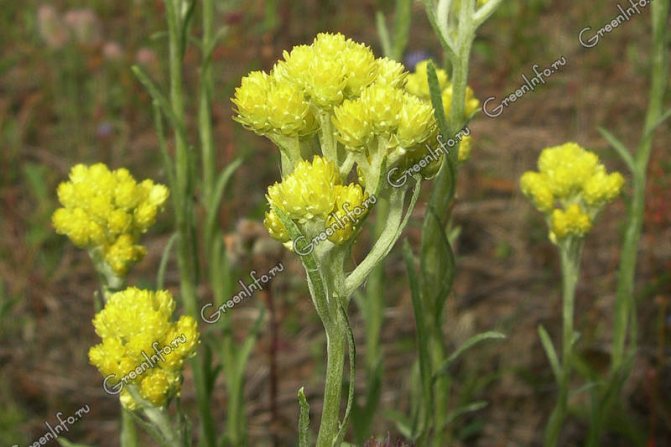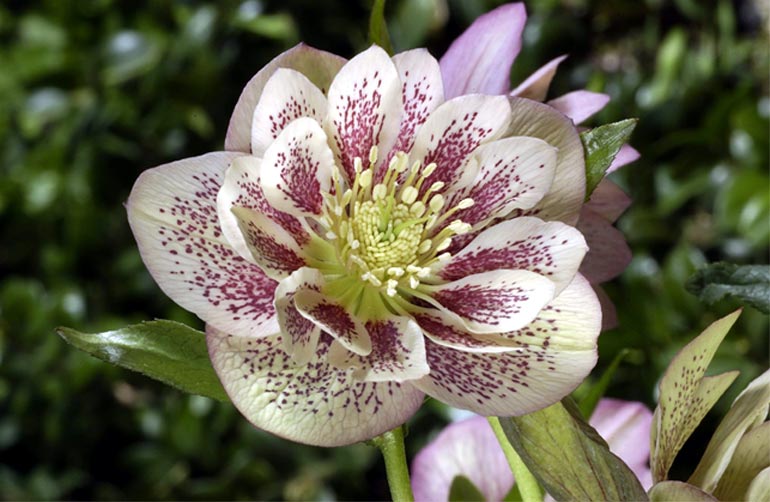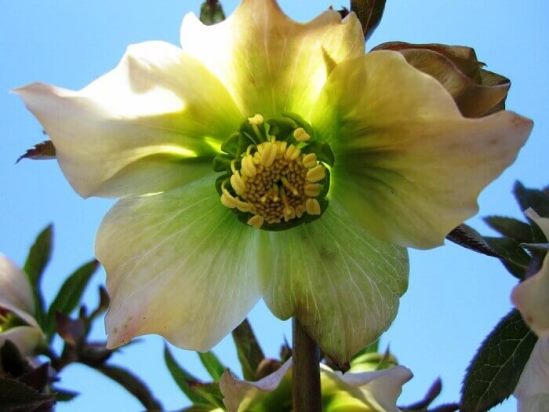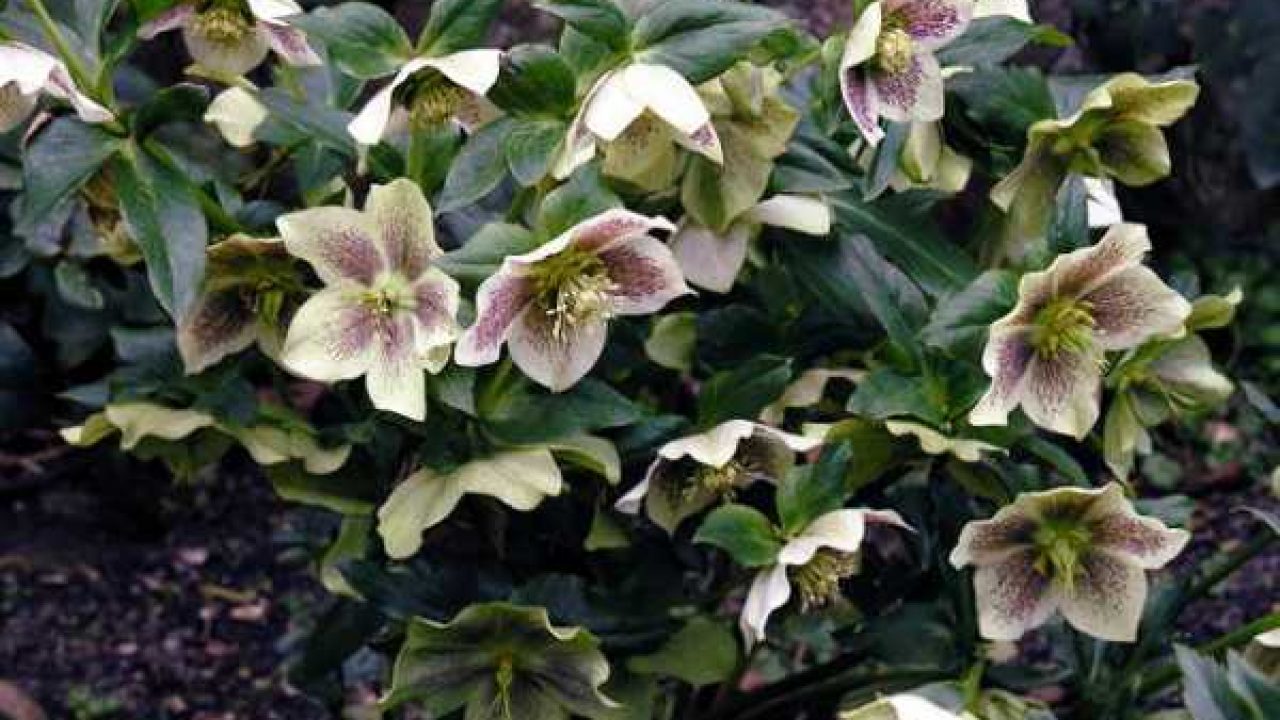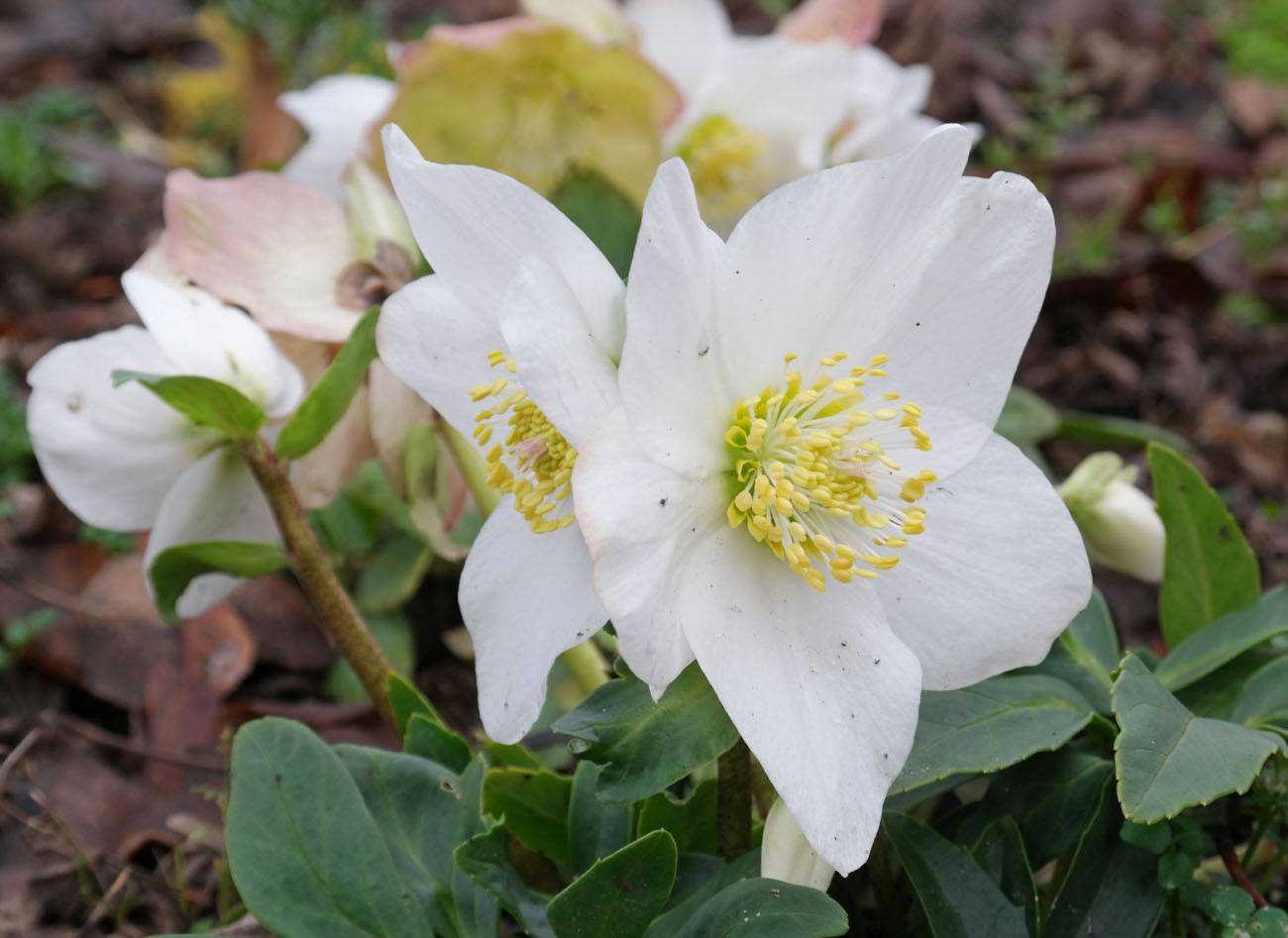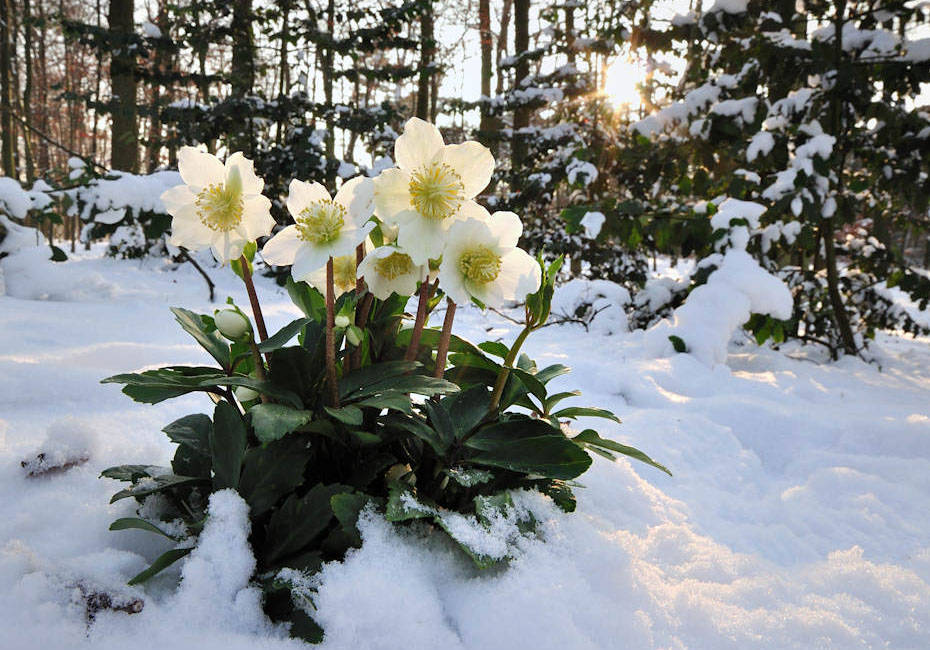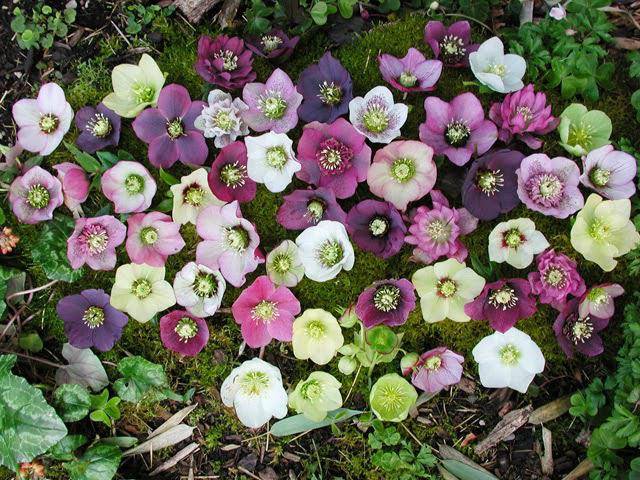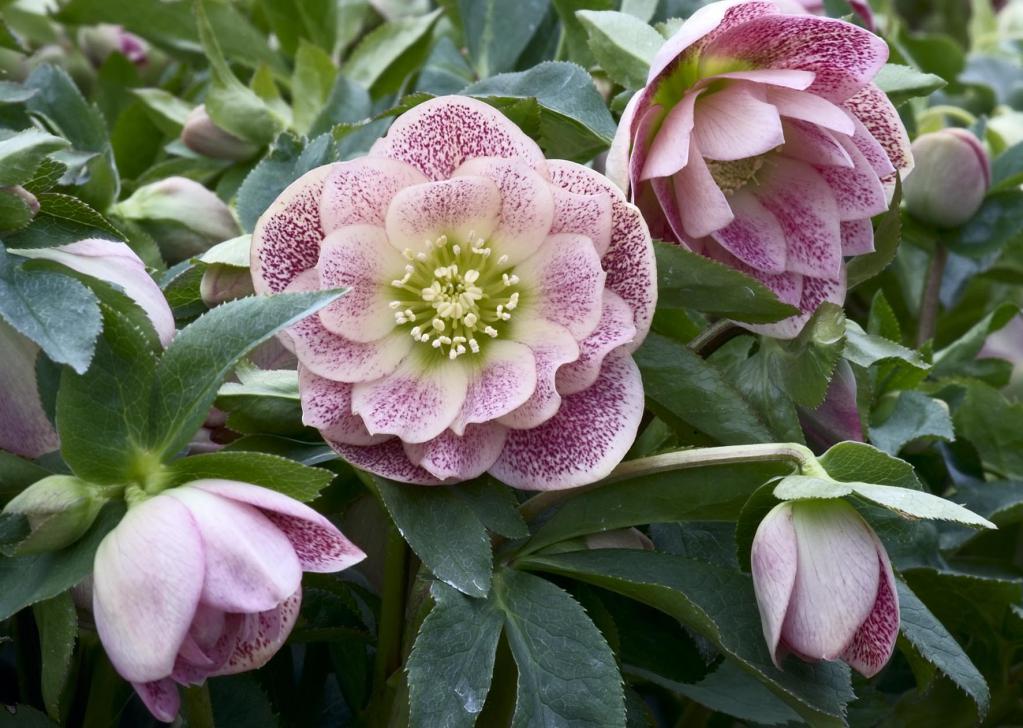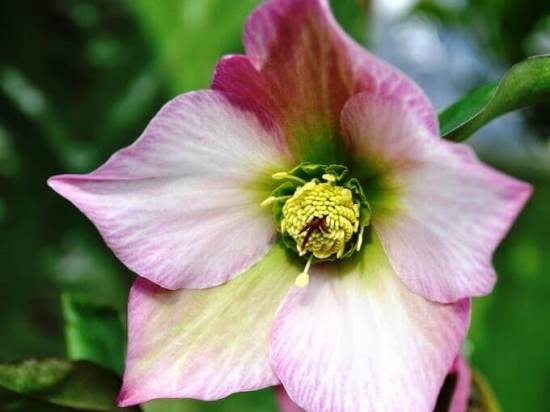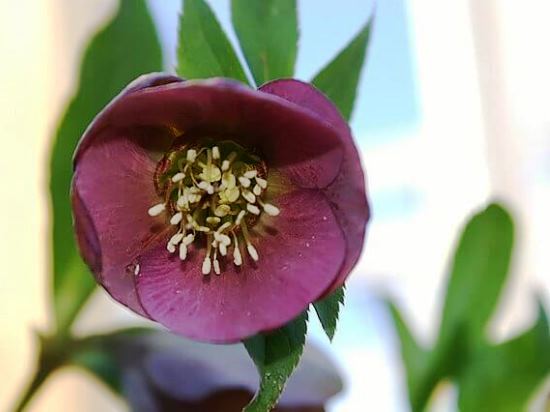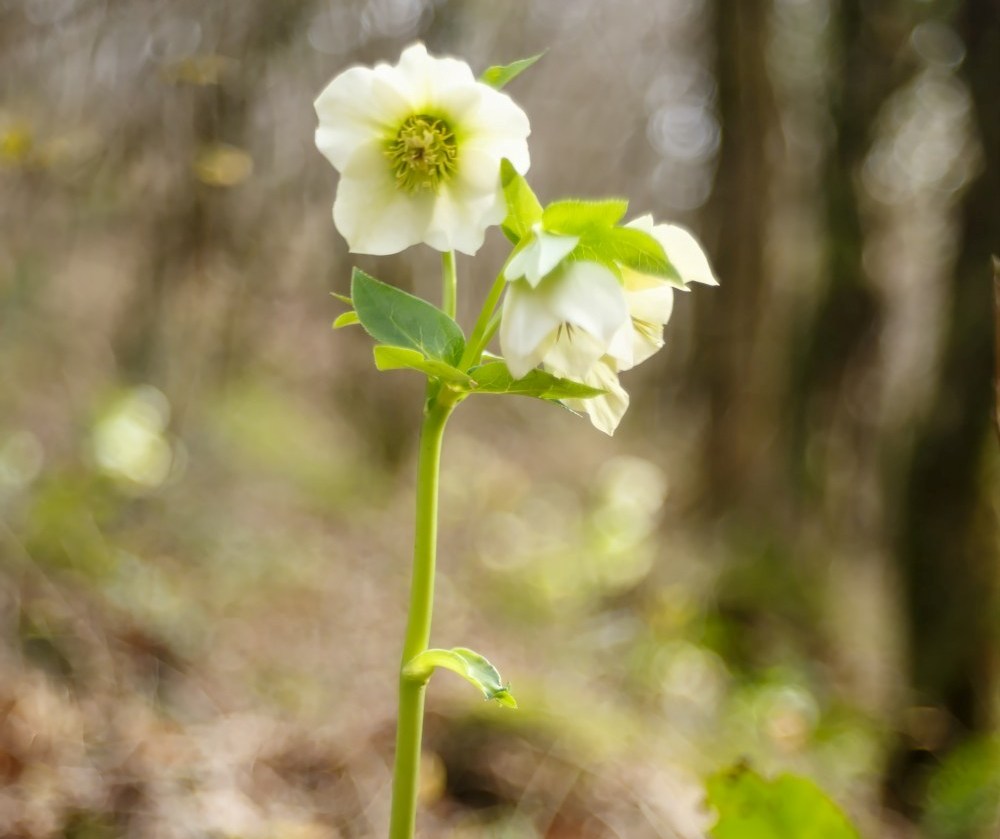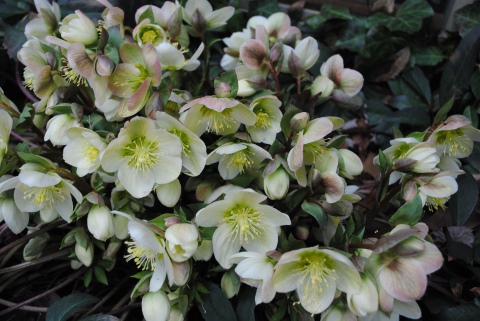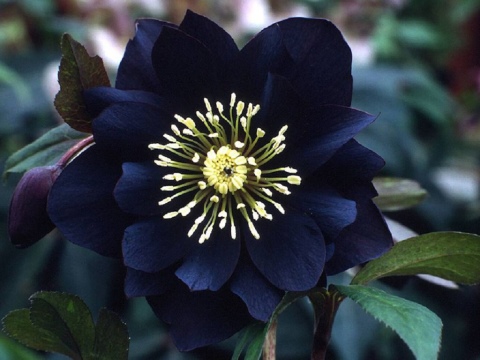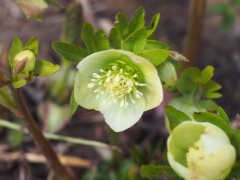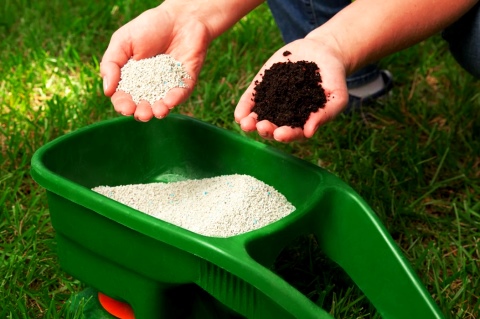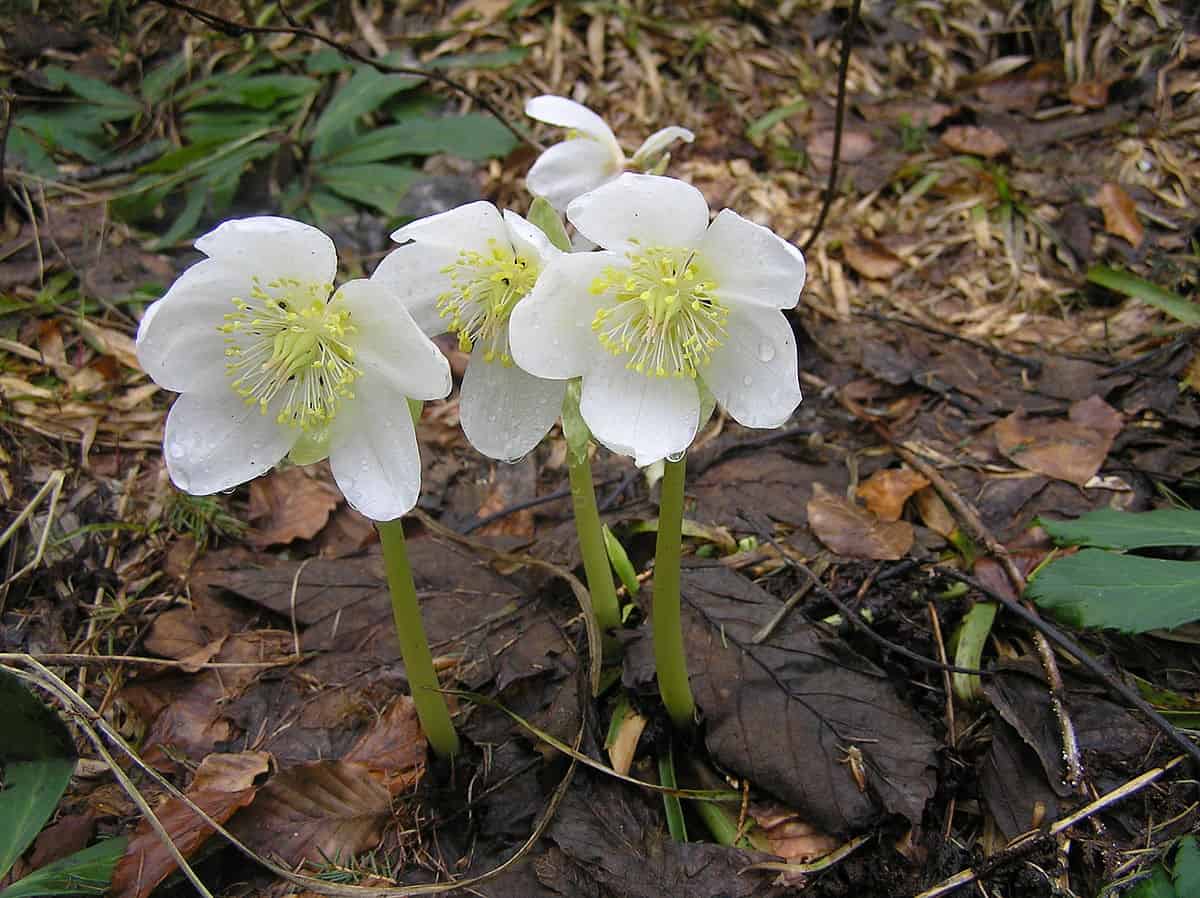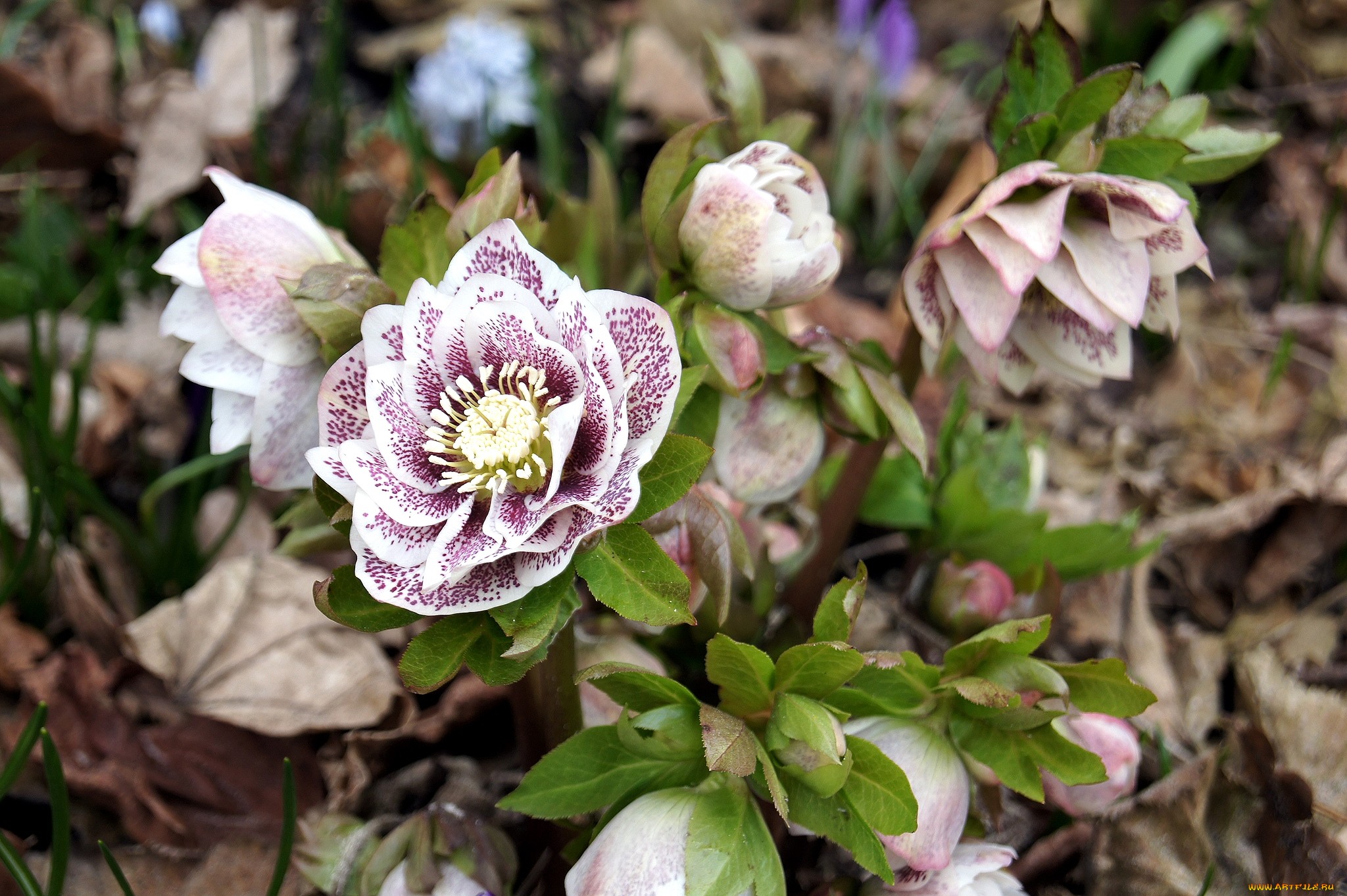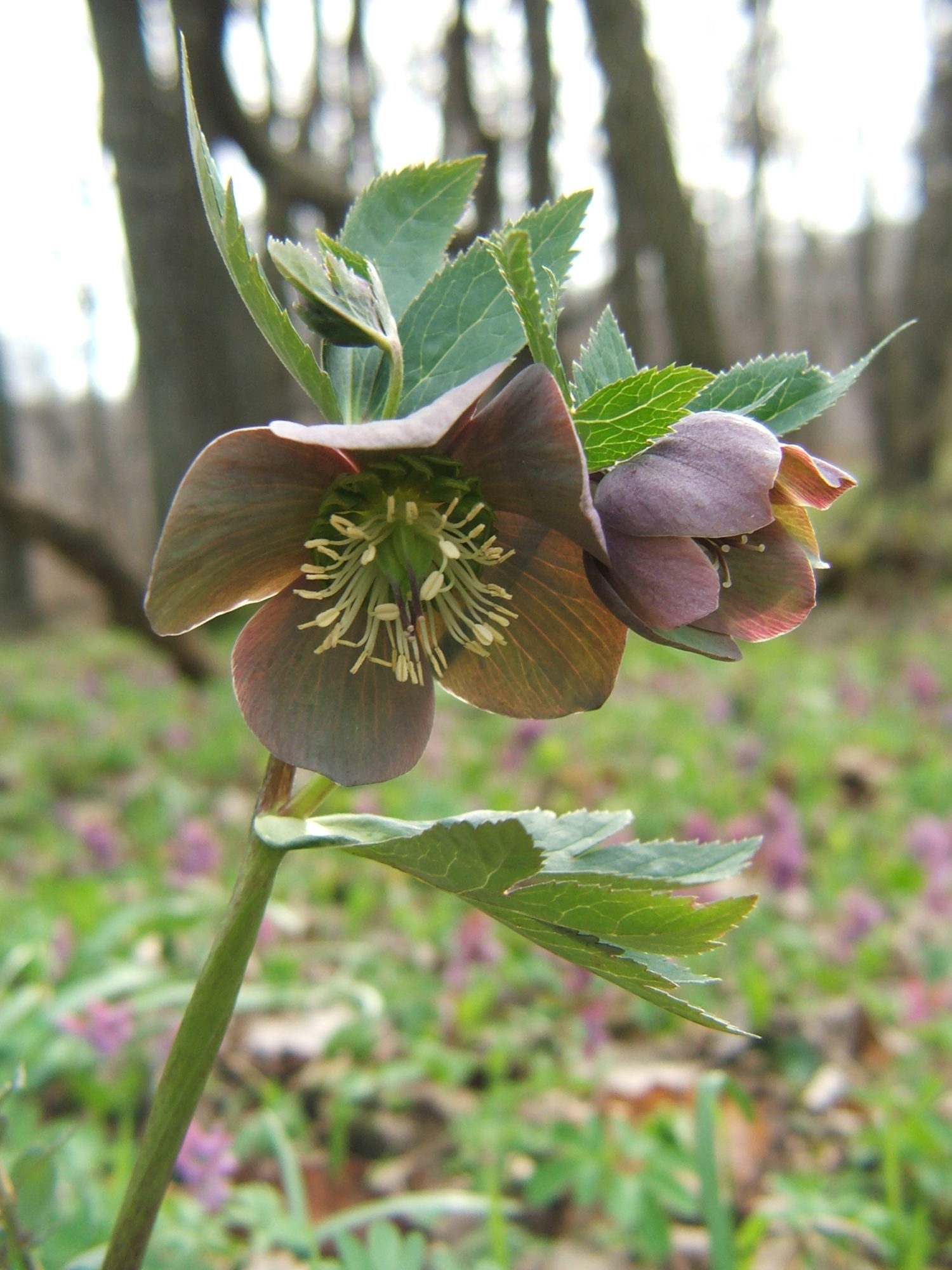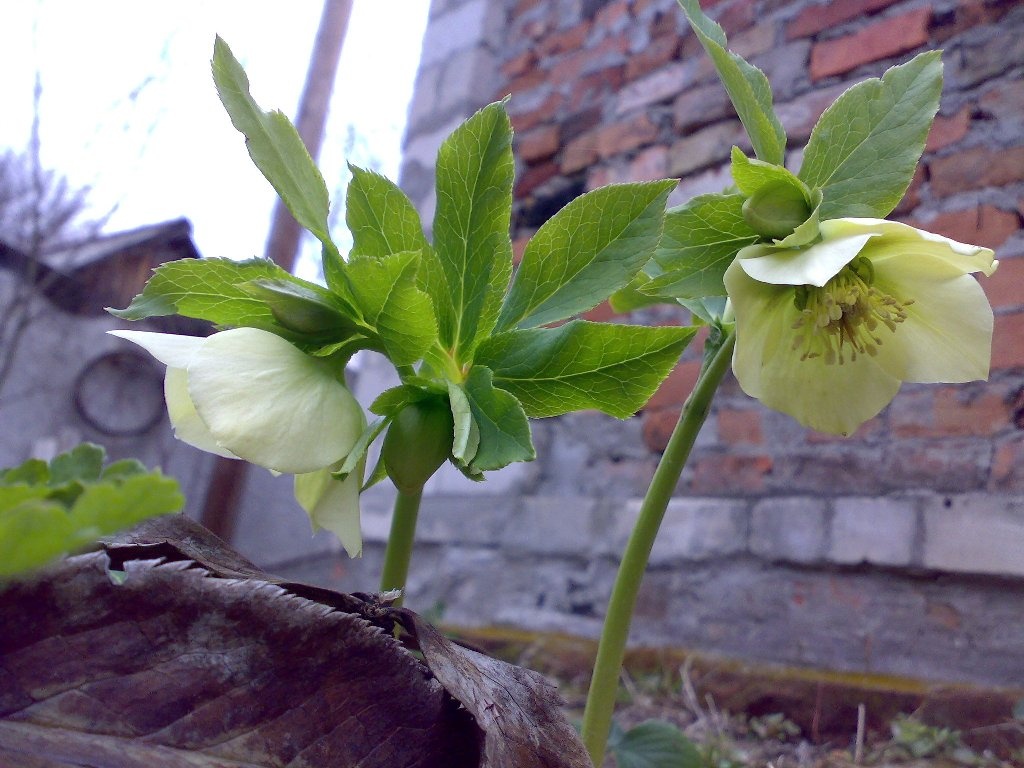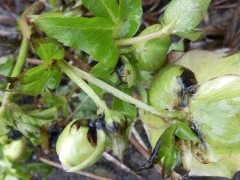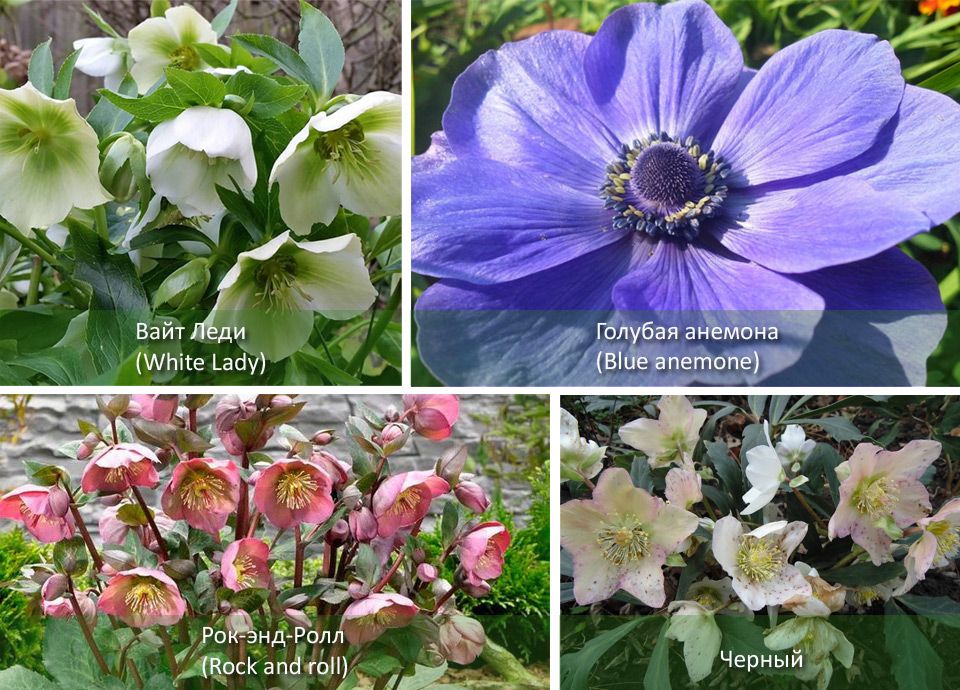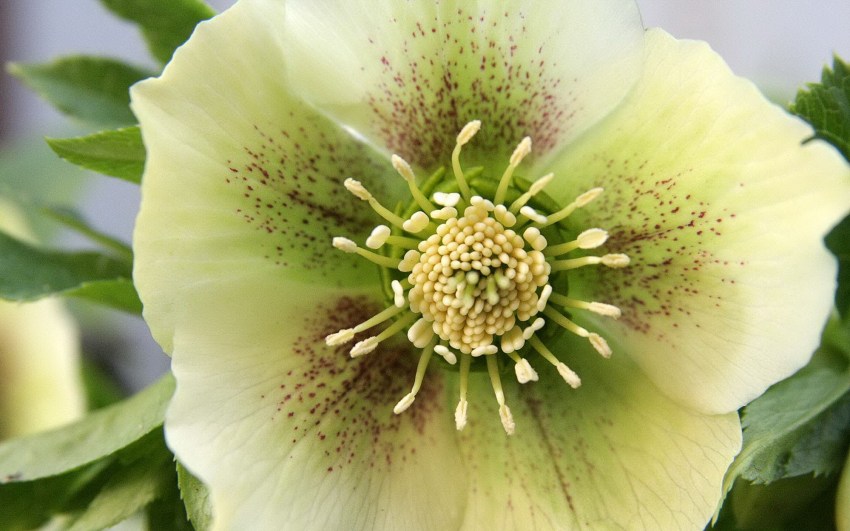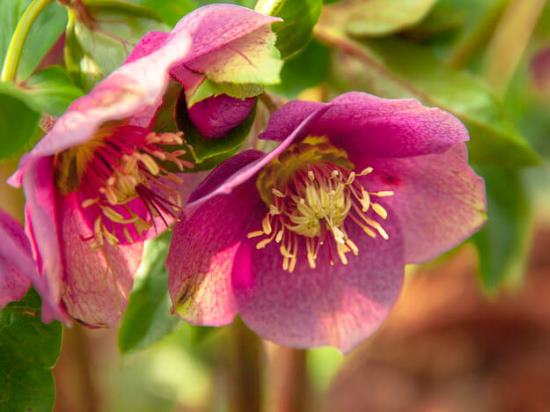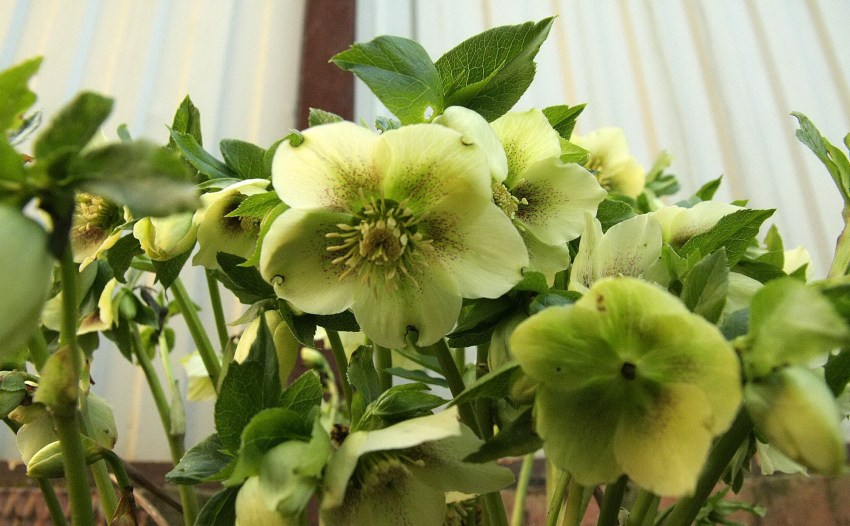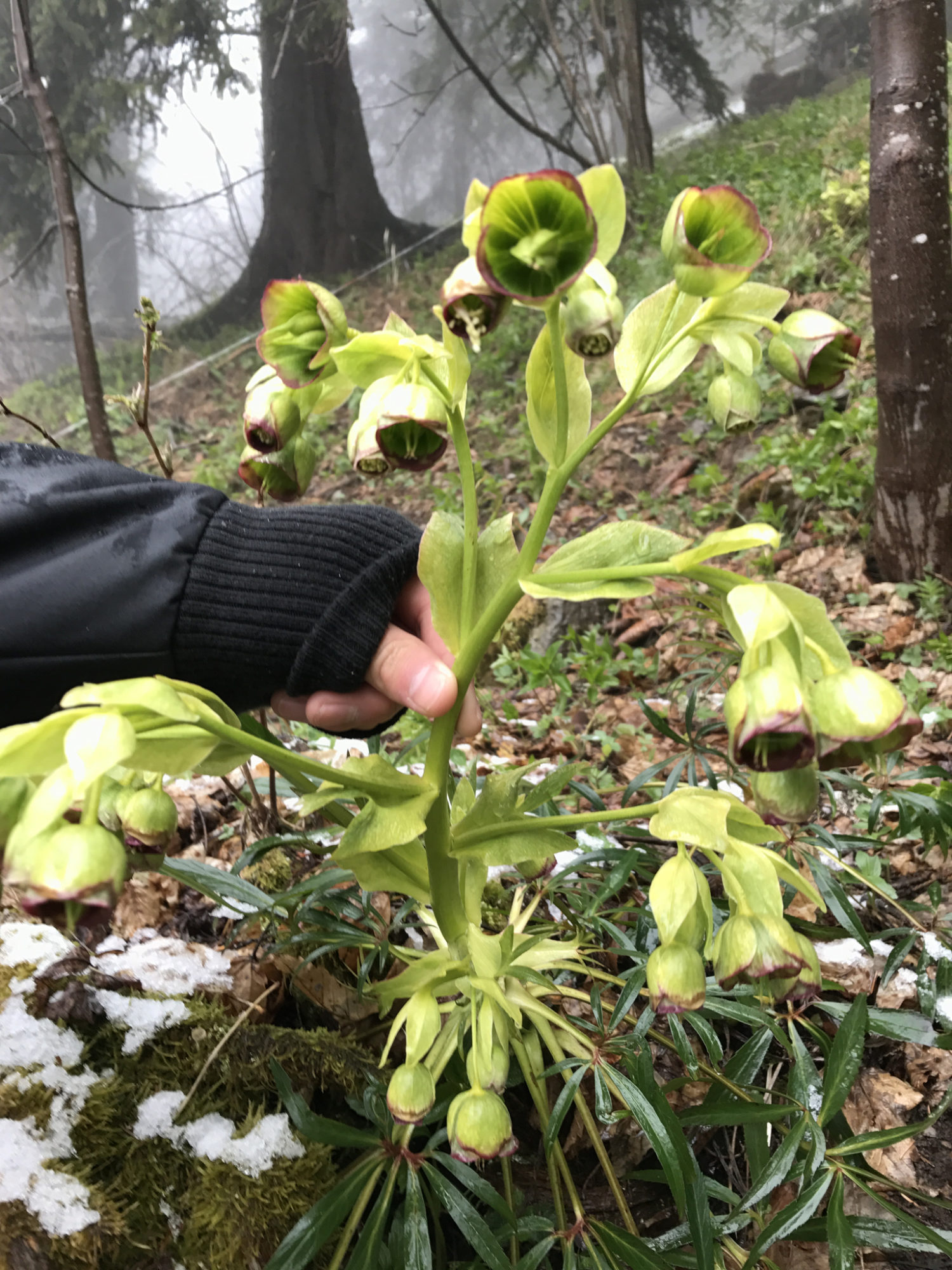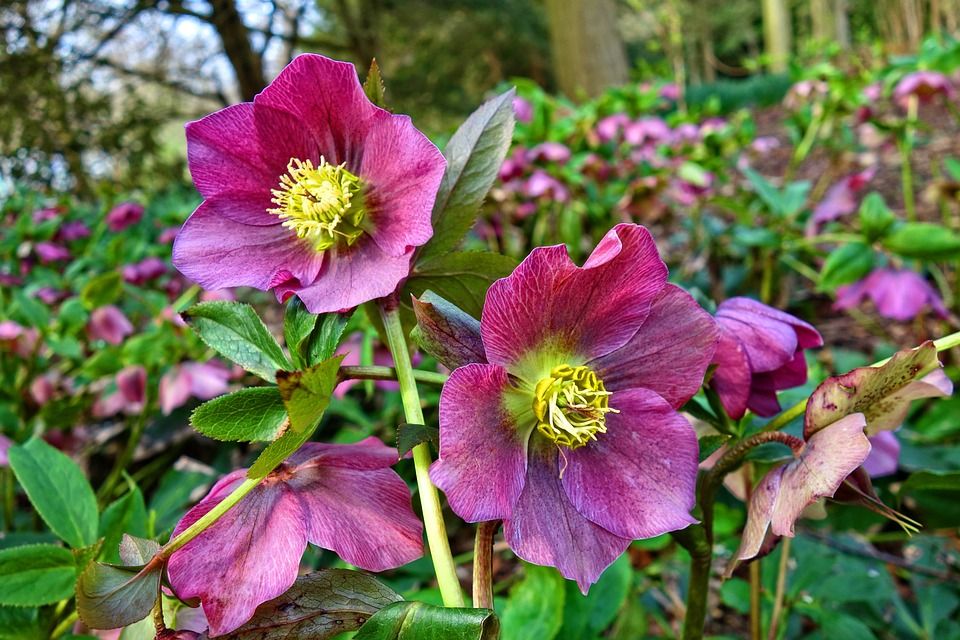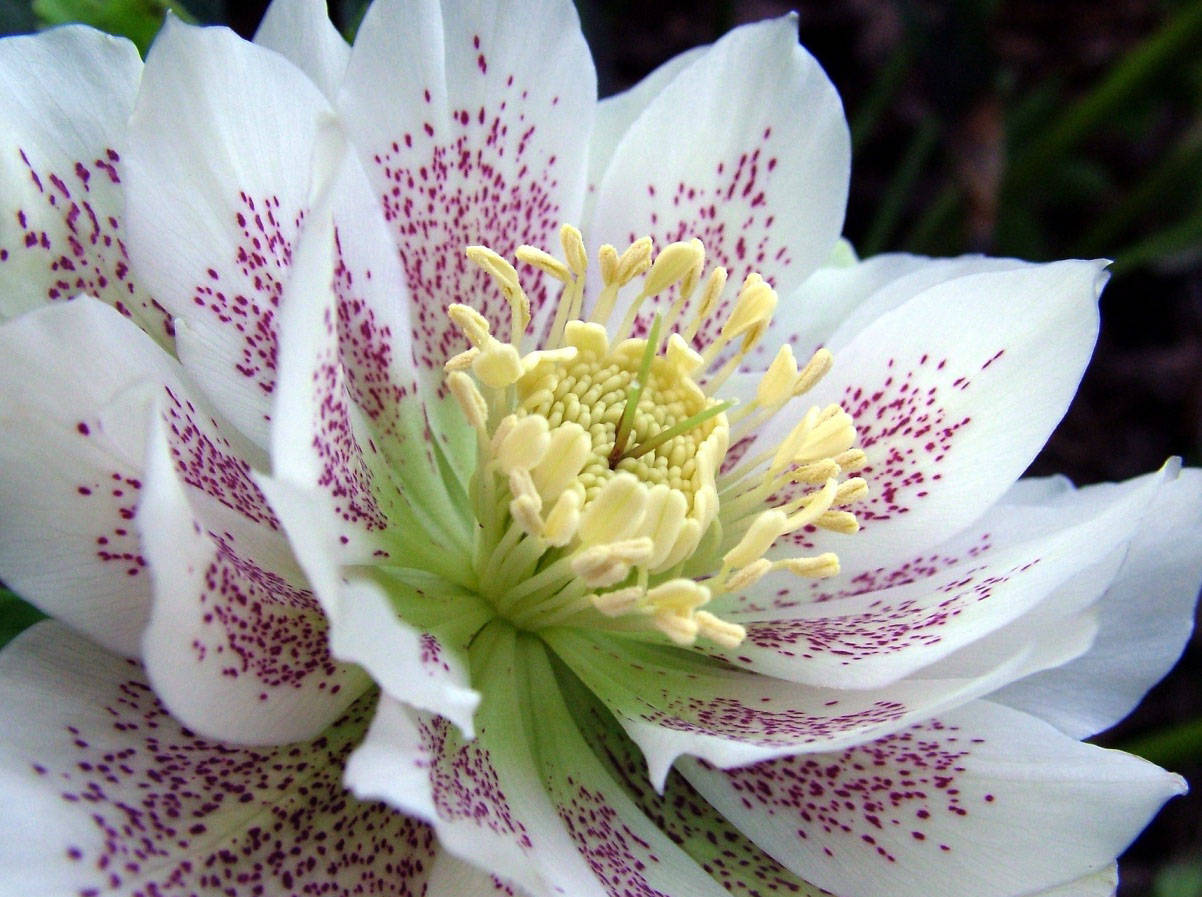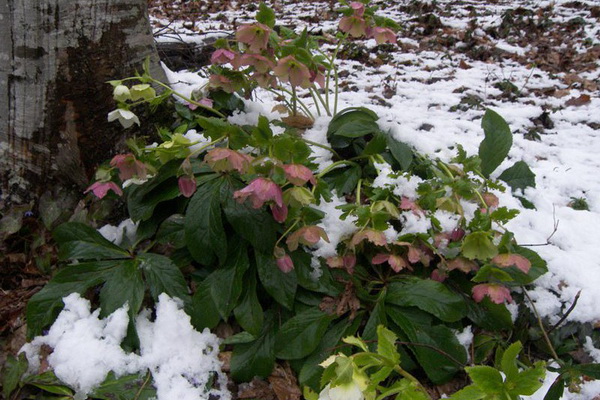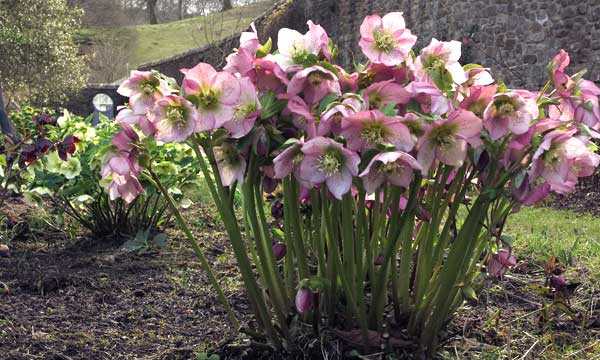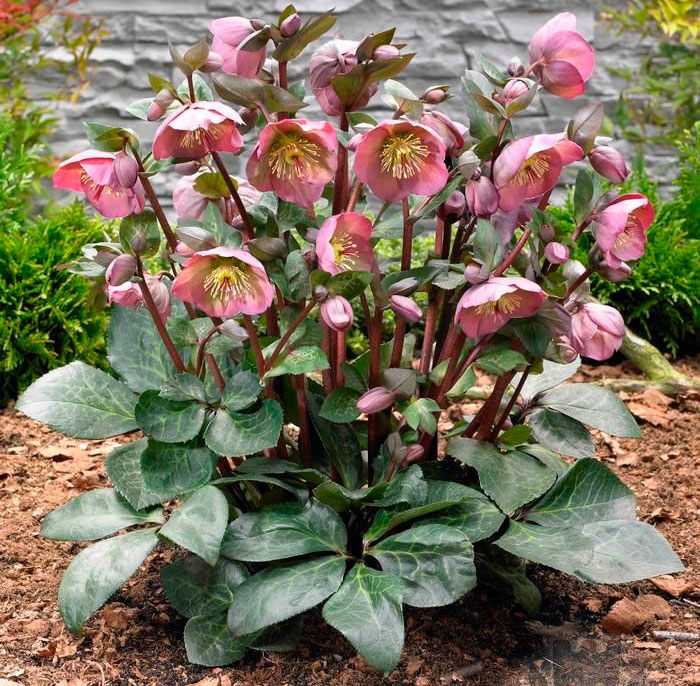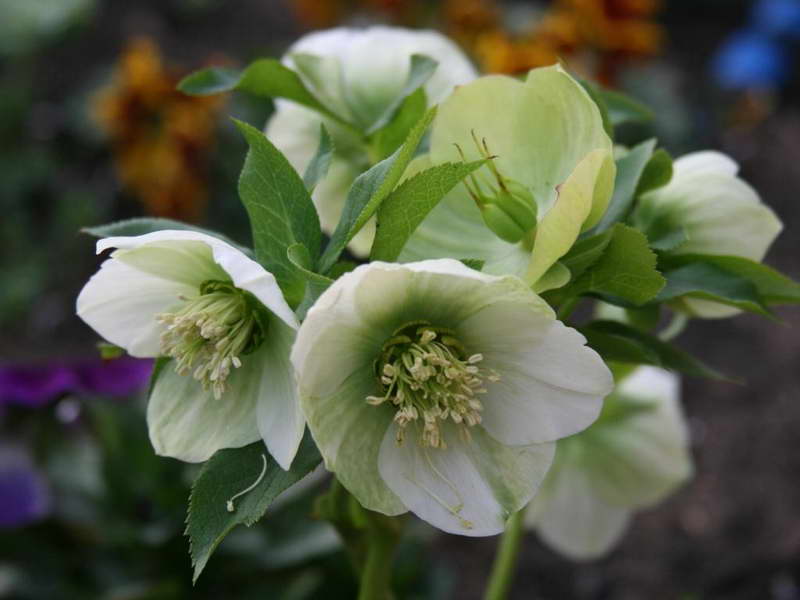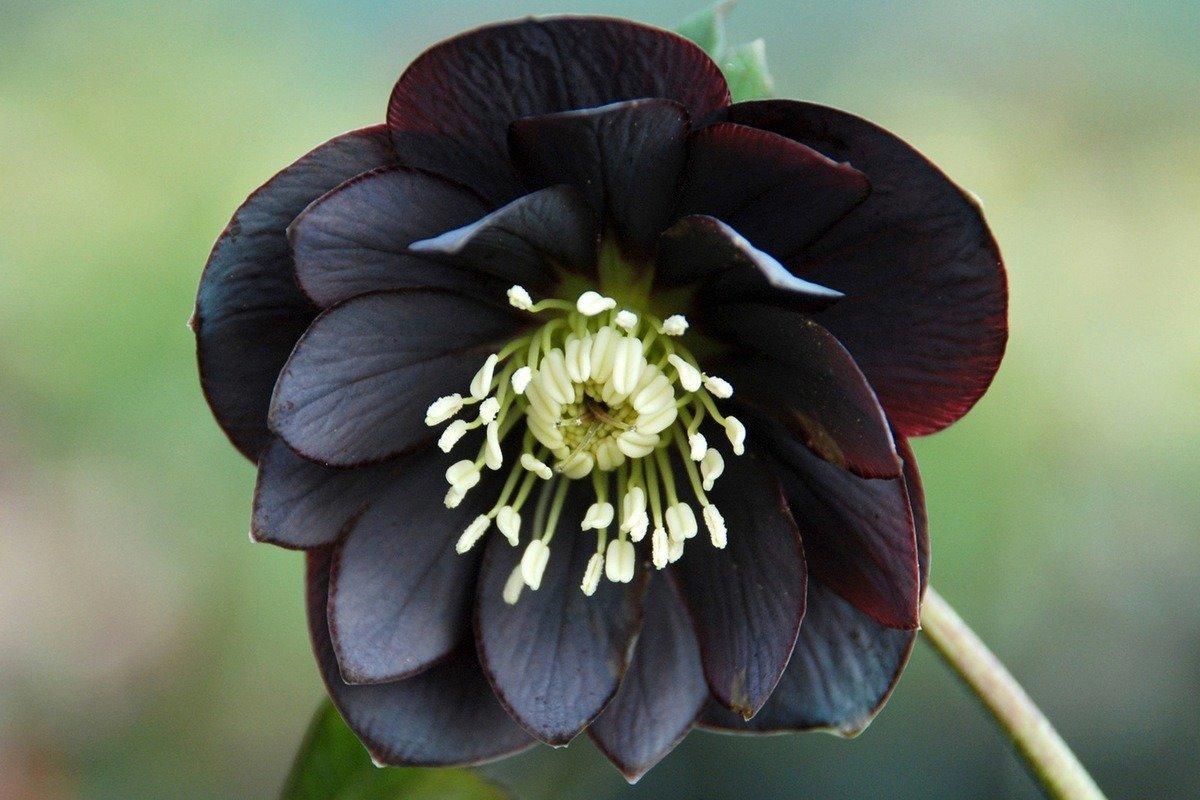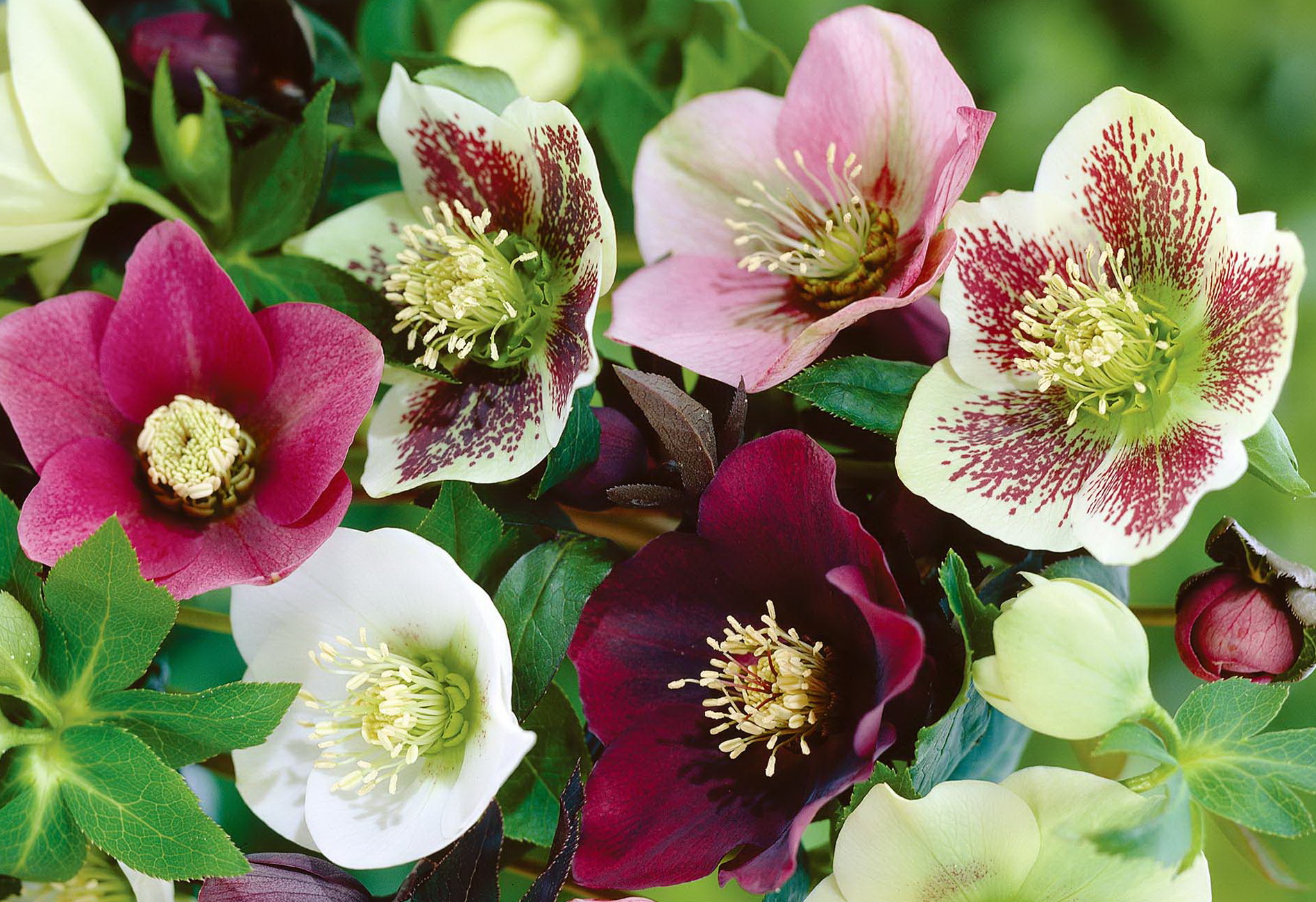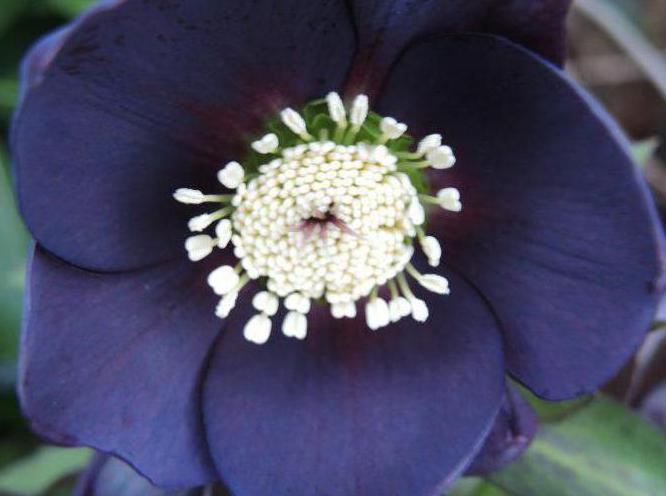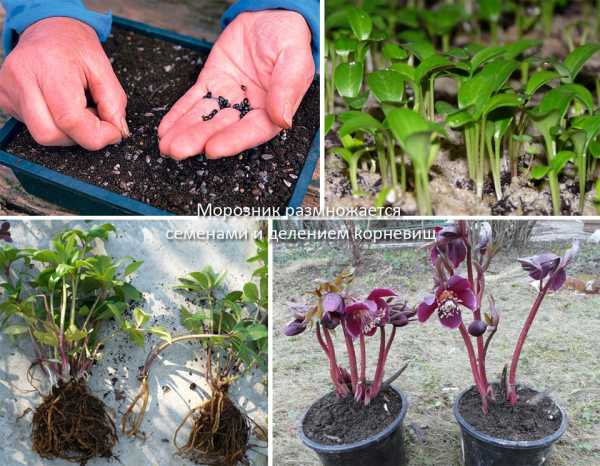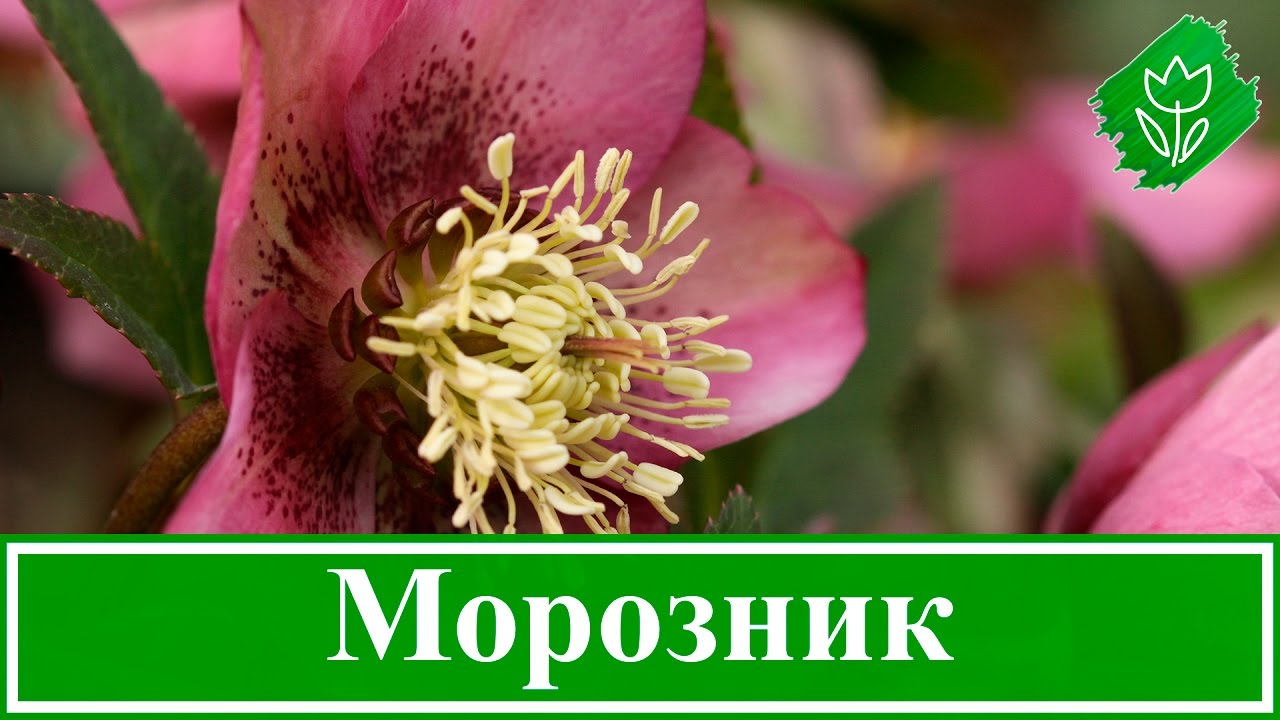How to propagate hellebore
The hellebore is propagated in two ways - by seed and by dividing the rhizome during transplantation, but the latter is not practiced very often due to the long survival of the plant in a new place.
Most often, a hellebore is grown from seeds.
Sowing hellebore seeds in open ground
They are harvested as they ripen from late May to late June and immediately sown in open ground.

Seedlings will appear early in the next growing season, but the likelihood of a high germination rate is greater compared to sowing in spring after dry storage.
Hellebore seeds lose their ability to germinate within a year.
It is possible to sow in open ground even later, the main thing is that at least 2-2.5 months remain before the onset of cold weather.
In the garden, grooves are made in loose, moist, humus soil and seeds are embedded in them to a depth of no more than one and a half centimeters.
Seedlings should be expected next year in the month of March, and the first flowers will bloom on them only in the 3rd year.
After the first 2-3 true leaves are formed on the sprouts, they are dived onto semi-shaded schools for growing, and transplanted to a permanent place after 2-3 years in September.
Growing hellebore seedlings from seeds
If it is impossible to sow immediately after collecting the seeds, they are necessarily satisfied with a double stratification - first warm, then cold.
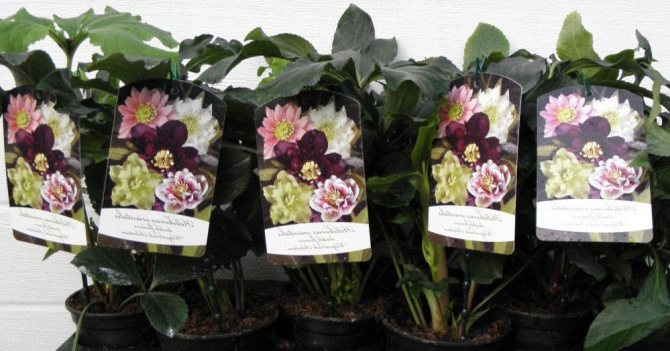
To do this, planting material is sown in containers filled with a peat-sand mixture in a ratio of 3: 1, and they are kept for 3 months at room temperature at about 18-20 degrees of heat.
For the next 1-3 months, containers with crops are moved to a cooler place, where the air temperature is about 4 degrees above zero.
Moisturize slightly and make sure that mold does not appear on the surface of the soil mixture. After a month or later, the first shoots begin to hatch.
In the spring, after return frosts on the soil, seedlings dive into semi-shaded places on the site, maintaining a distance of 20 cm between them, or into a greenhouse for further growing.
Dividing the bush
It is possible to propagate the hellebore by dividing the bush immediately after the end of flowering or at the optimal time for transplanting in early spring or with the arrival of autumn.
The root is divided into several parts and transplanted into pre-prepared pits.
Vegetative propagation is good because all the decorative characteristics of the parent plant are probably preserved.
With seed reproduction, there is no such confidence, usually varietal characteristics are lost, and the features of the natural species participating in the creation of a hybrid appear.
Hellebore care
Taking care of such a flower is quite simple. Before the hellebore blooms in springtime, all old leaf plates must be cut off. This is necessary so that the plant does not become infected with fungal spot. Young leaves grow after the plant stops blooming. After the flowers wither, it will be necessary to sprinkle the soil around the plants with a layer of mulch (compost or decomposed peat). If the weather is hot, then the hellebore must be systematically watered, and weeds must be removed in a timely manner and the soil surface must be loosened. It also needs to be fed 2 times per season with mineral fertilizer and bone meal.
Hellebore propagation
These flowers are often grown from seeds, but they can also be propagated using vegetative methods. Sowing for seedlings is carried out in the last days of June, immediately after the ripe seeds are collected. To do this, use humus, moist, loose soil, and the seeds should be buried by about one and a half centimeters.The first shoots can be seen in March next year. Grown seedlings, after the appearance of 1 or 2 pairs of leaf plates, must be dived into the flower bed (it must be located in shade). There hellebores will grow for 2 or 3 years. The transplant of mature seedlings to a permanent place can be done in September or April, while the gardener will see the first flowering only 3 years later, after the plant has fully recovered after transplantation. It should be borne in mind that the stinking hellebore multiplies well by self-seeding.
This plant is also propagated by dividing the bush. In spring, when flowering ends, those bushes that are 5 years old should be removed from the ground
The rhizome must be carefully divided into several parts, then the cuts are sprinkled with crushed coal, and then the cuttings are planted in pre-prepared holes. In the spring, the black hellebore is propagated in this way, and for dividing the bushes of the eastern hellebore, it is recommended to prefer the autumn time
Diseases and pests
Hellebore leaves can attract gastropods such as snails and slugs, as well as mice, aphids, and also the caterpillars of the hop worm can harm it. To kill mice, bait with poison is used, which should be placed in those places where these rodents were seen. Slugs and snails are robbed from bushes by hands, and insecticides are used to kill insects, for example, you can get rid of caterpillars with Aktellik, and aphids with Biotlin or Antitlin.
The hellebore is most often affected by anthracnose, downy mildew, and ring spot. It should be remembered that aphids are a carrier of spotting, in this regard, it is necessary to take measures to combat such a pest in a timely manner. The infected parts of the bush are cut and destroyed, and then the plant and the soil around it are treated with a fungicide. If brownish-black spots with a barely visible ring pattern appear on the leaf blades, this means that the hellebore is affected by anthracnose. Infected leaves must be cut off and burned, while the bush is treated with a product that contains copper. If new leaf plates do not grow on the bush, and those that have already grown undergo deformation, spots of a dark color appear on the front surface, and a gray bloom appears on the seamy surface, this means that it is affected by downy mildew. Infected parts of the plant should be cut out, while the bush and the surface of the site will need to be sprayed with copper oxychloride or Pervikur.
You should know that the hellebore is distinguished by a rather high resistance to diseases and harmful insects, and problems with it begin after violations of the rules of planting or care, for example, the plant was planted in overly acidic soil. In order to find out the acidity of the soil, you can conduct the following test, for this you need to collect 1 small spoonful of earth, pour it on the glass, which should be on the surface of a dark color, then slightly moisten the soil with table vinegar. Then you need to evaluate the result:
- a large amount of foam indicates that the earth is alkaline;
- medium foam means the soil is neutral;
- the absence of foam indicates that the soil is acidic.
In order to fix acidic soil, it is recommended to add wood ash, fluff lime or dolomite flour to it.
How to grow hellebore and how to propagate this garden flower
Look carefully at the photo of the hellebore garden flower: if you take a responsible approach not only to the process of placing the plant in the garden, but also to further care for it, the winter house will give a magnificent color every year:
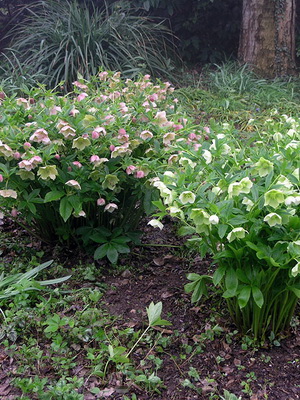
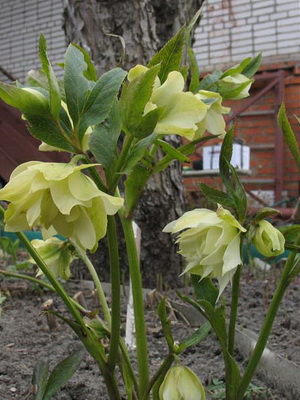
- Caring for a perennial is not difficult and difficult to accomplish.
- First of all, in early spring, when the buds are about to begin to appear, you just need to remove the dried old foliage so that it does not become a hotbed of infection and fungal spotting for new shoots and shoots.
- Secondly, after flowering stops and withers, it is imperative to mulch the ground around the seedlings with compost or peat.
- Thirdly, in the summer, it is necessary to regularly water the winter house and carefully weed and loosen the area where it grows.
- Experienced gardeners also advise not only to be serious about planting and further caring for hellebore flowers, but also to feeding it, which should be carried out at least 2 times per season. Usually, bone meal or mineral fertilizers are used for this.

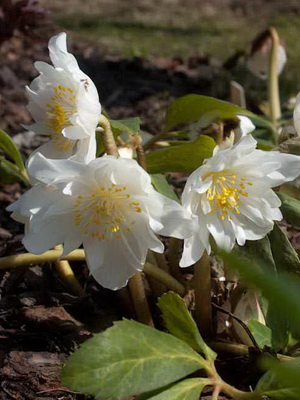
It is possible to propagate hellebores by seeds, but it is not so easy. If you sow fresh seeds, they will sprout in the spring, dry ones will need two periods of stratification, that is, two winters. And you will have to wait 3-4 years for flowering.
However, those who decide on this method of breeding should know a few useful tips. One of them concerns the fact that the seeds of the plant must be sown immediately after they are ripe and harvested - that is, around the end of June. You also need to understand how to plant hellebore using seedlings: in particular, the material is placed in loose and well-moistened soil to a depth of at least one and a half centimeters. Seedlings can be observed next year, in March. Only after the sprouts have several leaves can they be moved to the flower bed, where they should be for another two years.
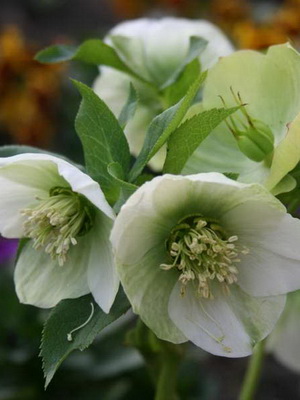
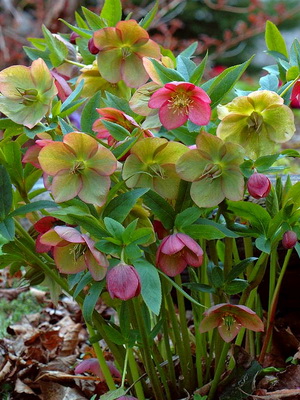
Pay attention to the photo of the hellebore garden flower, the description of which was presented above: this plant was born not using the seed method of reproduction, but thanks to the division of the bush. This technique involves digging up five-year-old winter houses, dividing their root system into parts and replanting to new places.
It should be noted that in this way in the spring you can breed a species called black, and in the fall - an oriental one.
Planting a hellebore in open ground
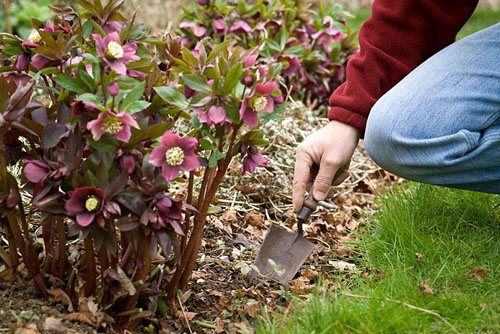
What time to plant
Without a transplant, such a flower can be grown in the same place for about 10 years. When choosing a site for planting, it should be borne in mind that the hellebore reacts extremely negatively to transplantation. In this regard, the choice of a suitable location must be taken very seriously. For growing this flower, it is best to choose a loose, moist, neutral, clayey soil that must be well drained. The plot should be shaded and it is good if it will be located between shrubs and trees. To achieve maximum decorative effect from such a flower, it is recommended to plant it in small groups. The hellebore should be planted in April or September.
How to plant
The size of the planting holes should be 30x30x30 centimeters, while a distance of about 0.3 meters should be maintained between the bushes. The ½ part hole should be covered with compost. After that, the rhizome of the hellebore is placed in a hole and gradually covered with soil, which is well compacted. The planted flowers must be watered. The planted bushes need to be watered abundantly and often within 20 days from the moment of planting.
Planting and breeding
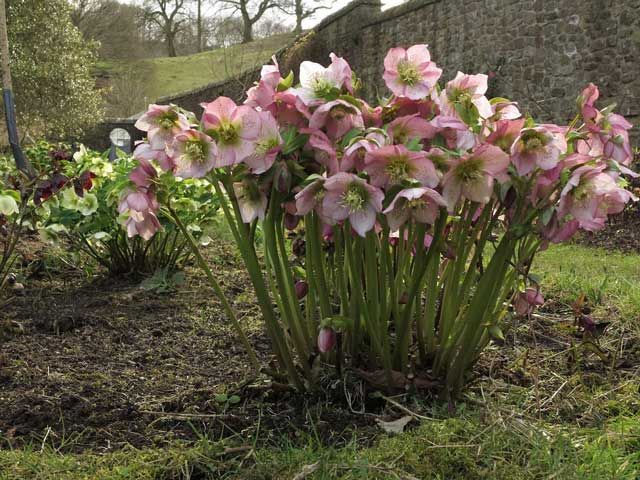
When planting a winter house, it is necessary to adhere to a number of rules. He really does not like acidified soils. Therefore, when preparing a site in advance, it is necessary to take measures to deoxidize the site selected for planting. In addition, if the soils are poor, then peat, organic fertilizers, ash should be added and the soil should be dug up. Such work is done 2-3 weeks before disembarkation.
Some gardeners spread pebbles or small pebbles under the soil mixture to avoid stagnant water and provide drainage. But this is optional. It is enough to provide moderate watering as needed and periodically loosening.
Sowing with seeds
This method is not the most common among flower growers. The seeds of the plant do not retain their germination for long. Therefore, it is advisable to sow immediately after collecting seeds in the fall. It is possible to do this in early spring, but you will have to wait for seedlings for a long time.
The soil is prepared in a timely manner and small holes 1-1.5 cm deep are made in the prepared area where several seeds are placed in order to increase the percentage of germination and make the bush thicker. After which they are covered with earth. The distance between the grooves should be at least 25-30 cm, since the flower grows quickly, it will need some area.
Growing seedlings
The most common way to get a beautiful plant is to grow seedlings. For this, a soil mixture is prepared from soil, peat and sand, in equal proportions. This can be done in the fall after the completion of field work. Seeds are placed in prepared containers with soil and sprinkled on top by 0.5-1 cm. After that, the earth is moistened and the pots with plantings are lowered into the basement. In February, they should be obtained and placed on the windows, preferably from the north side, to exclude direct sunlight and an excess of light.
Planting seedlings can be done in the winter at home. For this, in February, the soil is prepared in a similar way, and seeds are planted. The soil is moistened and the finished containers are covered with foil to create a greenhouse effect. They are exposed on windows where there is no direct sun.
After the appearance of full-fledged shoots, it should be transplanted to a permanent place by carefully picking.
Planting a hellebore in open ground

The main rule that should be observed when transplanting is the inadmissibility of complete exposure of the root system. Small plants grown by seedlings must be carefully dug up and transferred with a piece of earth into previously prepared moistened holes, 2-3 cm deep. The tip of the main root is pinched. You can use scissors or tweezers for this.
Reproduction by dividing the bush
Many growers prefer to propagate the hellebore by dividing a healthy plant into several. This method is convenient because the first flowers will appear next year. When propagated by seeds, they will have to be expected only after 2-3 years.
A well-developed flowering plant is selected for division. This is done either after flowering is complete, or in early autumn.
The procedure must be carried out quickly and with caution.
The wintering area is dug up and shaken off the remains of the soil so that the buds with tied leaves are clearly visible. After that, the plant is cut into two parts with a sharp knife. It is not advisable to divide into smaller pieces. The place of the cut is processed with charcoal. And the resulting plants are planted in a non-permanent place. At first, they should be watered in sufficient quantity to improve survival.
How to care for a hellebore outdoors
The hellebore belongs to unpretentious plants, but he does not like to be disturbed. It grows best outdoors. Therefore, choose a location so that the plant does not have to be repotted. Keep in mind that the wintering house is capable of self-seeding. To grow the plant successfully, mulch it regularly, feed it and loosen the soil around the flower. For feeding, use every 3 months. bone meal or ash. At the end of the flowering period, mulch the wintering house. To do this, use garden compost, leaf humus.
Water the hellebore during dry periods to keep the soil from drying out. From an aesthetic point of view, these plants look good when planted in groups. Taking into account all the variety of colors, landscape designers create whole compositions, which harmoniously fit tulips, crocuses, hyacinths and chrysanthemums. The flower looks good in combination with primrose, peony and volzhanka.
At low subzero temperatures from -35 C and more, the leaves of the hellebore are damaged. If you notice that this has happened, remove the frostbite leaves. Do not worry, damage to the foliage of the winter house does not affect the further development of the plant and its flowering. The rhizome remains healthy and powerful, and the new wintering flowers will delight you that same year.
If spots appear on the leaves of the hellebore, spray with special preparations. Use Oxyhom or Topaz fungicides. With excessive acidity of the soil, black spots appear on the leaves of the wintering house. To treat a flower, add lime to the soil, and remove the damaged leaves. If the plant is affected by diseases of a non-infectious nature, this indicates either an increased level of acidity of the soil, or an excessive amount of moisture, or improper nutrition of the hellebore.
Found a mistake in the text? Select it, press Ctrl + Enter and we'll fix it!
Updated: 05/13/2019
Planting a hellebore
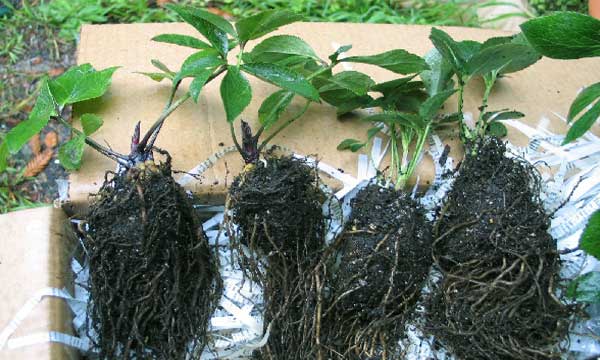
Landing dates
They mainly depend on your climate zone. Given that the hellebore is planted in the spring, it can only be planted by steady heat. That is, when the threat of spring frosts has finally passed. Only when the hellebore is thoroughly rooted and gets stronger during the summer season, it will not be afraid of severe frosts. And in March, when the ground is still covered with snow, and the primroses - crocuses, primroses and snowdrops are just planning to bloom, the hellebore will delight you with a beautiful flowering.
Landing place
It's great that hellebore can be safely planted among bushes and trees. During the flowering period, they all stand without foliage, and do not shade the plant. In summer, on the contrary, they create partial shade, which is beneficial to the hellebore. And this is not the only reason for choosing such a planting site - fallen leaves of trees mulch and fertilize the earth. When choosing a place for planting a hellebore, keep in mind that this flower tolerates transplants hard and painfully. Therefore, the place is chosen for a long time. A hellebore can grow for ten years or more without a transplant.

Landing
The technique of planting a hellebore is very similar to planting another "long-liver" flower garden - a peony. The best decorative result can be obtained not from single, but group plantings of hellebore. In groups of eight to ten seedlings, planting them at a distance of 30-35 centimeters from one another. Landing holes are usually prepared with dimensions 25X25X25, but these are average parameters. You should be guided by the size of the root system of the hellebore. The hole should be about twice the size of the root system. Do the depth based on drainage layer... Its creation should not be neglected. It will remove excess moisture from the roots of the plant and prevent waterlogging with subsequent decay of the roots. A 5 cm layer of sand can be used as drainage. A 10-centimeter layer of fertile soil will not be superfluous. This can be greenhouse soil, compost soil, or mixtures of these. Therefore, the landing hole is prepared with these layers in mind.
After planting, the hellebore is watered abundantly. After watering, the earth will sag slightly - add more earth. The root system must be completely covered with earth.
Within a month after planting, watering should be given special attention and carried out regularly.
Growing seedlings from seeds
Planting and caring for a hellebore is a laborious task. Achieving the formation of a strong plant is possible only with great patience. Seeds must be planted as soon as they have been harvested, without even allowing them to dry out.
Wooden boxes are great for seedlings. Their height is at least 10 cm. In this case, it will be possible to fill in the required amount of soil. Holes must be made at the bottom of the box to allow drainage. Expanded clay can be poured on the bottom. It improves the drainage process.
Sow shallow. The maximum depth is 1 cm. 10 cm is left between the furrows. This is due to the fact that the hellebore flower (photo in the article) is difficult for transplantation. If the dive can be prevented, the plant will most likely survive and grow back to standard size. Leave at least 5 cm between seedlings. Seeds that have already been sown should be taken to the garden. They should be there until spring.Do not forget about watering, moisturizing the soil when it dries up.
When the seedlings have already sprouted, they can be taken home
After that, it is important to take proper care. Planting a hellebore in this case will be successful.
Next, you need to water it in a timely manner. In the first year, only 2-3 leaves will appear. You should not worry, as the plant develops for a long period. A full-fledged seedling will be formed only after 3 years. Only then can it be transplanted into the ground. This is done in the off-season. In the 5th year, the hellebore usually begins to bloom.
Experienced gardeners do not want to give it a place in the garden due to the long development of the plant. In this case, they advise using a regular box. It should be planted tightly
When the seedlings grow up, they are carefully dived into the pots. You can use tweezers, a fork, toothpicks for this.
Any of these devices will allow you to "dig in" the root.
In this case, the transplant will take place with minimal damage.

The hellebore: what is he?
We recommend that you familiarize yourself
The hellebore is a flower loved by flower growers. The plant has many names: Christmas rose, bear's paw, winter house or helleborus. For a long time, these delicate herbaceous bushes were cultivated for their medicinal properties, but in recent years hellebore is increasingly found in flower beds and beds because of its beauty. There are 22 known plant species; in the wild, the flower is found in Central Europe, Western Asia, and the Mediterranean. Especially many varieties of Helleborus can be found in the Balkans. In different regions of Russia, the most common species grow, for example, black, reddish or oriental hellebore. All plants feel great in the beds and flower beds, they do not require painstaking care and decorate the garden throughout the season from early spring to mid-summer.
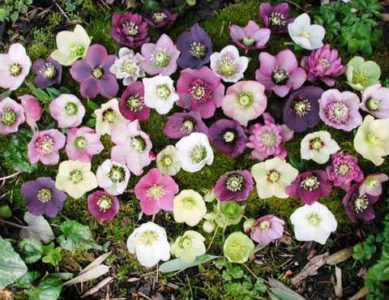
The appearance of the Gelleborus is quite spectacular. A thin, but strong stem, 20 to 50 cm long, is decorated with medium-sized, strongly dissected leaves on long petioles. Their texture changes with the seasons. In winter, the greens are dense and leathery; closer to spring, they fall off, making room for new leaves, delicate and velvety. In full accordance with its name, the hellebore plant is not afraid of cold weather and even tolerates a significant drop in temperature. The flowering time varies depending on the variety. Some hellebores bloom in December-February, others pick up color in spring. There are varieties that are suitable for growing in pots.
The plant has a powerful and well-developed root system, capable of extracting nutrients and moisture even from very poor soil. In the first year of life, the leaves are concentrated in the lower part of the stem; as it grows, the green mass is distributed more evenly. Large flowers with 5 wide petals are distinguished by a variety of shades. Depending on the variety, the buds can be pure white, pinkish, grayish or creamy. There are yellow, salmon, purple and violet variants, two-color hellebores look very elegant. In the center of each flower is a lush bunch of large yellowish stamens. They contain nectar that attracts pollinating insects.
Flowers bloom at the very beginning of spring or winter. The latter is more common in potted plants. The buds are formed until the end of June. After this, the fruiting period begins. The petals of the flower become denser and acquire a green tint, the stamens disappear, the pistils increase in size and form a kind of bunch of flat leafy fruits. After a while, these capsules open, and large black seeds are poured out of them, suitable for sowing.
When cultivating a plant, it is worth remembering that all its parts are poisonous. It is necessary to protect beautiful bushes from children and pets, it is better for people with sensitive skin to take care of the hellebore with rubber gloves. After contact with flowers, you should thoroughly wash your hands with soap and water.
Hellebore propagation
Hellebores are propagated by seeds or by dividing the bush. This is done depending on their type. Black hellebore, or "Christmas rose", is best propagated by dividing the bush in the spring. Eastern hellebore is best divided in autumn. But the stinking hellebore reproduces well by seeds, even by self-sowing, and does not tolerate division at all. But, if the faded flowers are not removed, the seeds will crumble and the next spring the plants will sprout up around the mother bush. They can be planted for growing on the garden bed.
Seeds
Seed propagation does not guarantee obtaining the same specimens as the mother plant, but this method produces a lot of planting material at once.
The method is simple, but more troublesome and long, 3-5 years will pass from germination to flowering. Very rarely (in ideal conditions!) The hellebore can bloom after 2 years.
You should be patient - and for the work! It is important to know that hellebore seeds quickly lose their germination, if possible, they are sown immediately after collection. After six months of storage, germination is lost by more than half.
When buying seeds, it is good to know and take this feature into account.
Sowing dates depend on the climatic zone. In the temperate zone, this period is the beginning of summer, the time of seed ripening. Seeds are sown in open ground. If you are late with sowing, you need to know that at least 3 months should pass from sowing to the first frost. Allocate a bed with well-fertilized, loose and constantly moist soil. Sowing is carried out to a depth of 1.5 cm. Seedlings will appear only next spring. When the plant grows stronger, two true leaves will grow, they are planted, preferably in partial shade, at a distance of 15-20 cm from each other. After two or three years, the grown seedlings are transferred to a permanent place. Transplanted with a lump of earth into the prepared pits.
If the seeds fall into the hands of a gardener at other times of the year, they are sown in pots. To do this, prepare a soil mixture of 3 parts of humus or compost and 1 part of sand. Seeds are also sown to a depth of 1 - 1.5 cm. Without forgetting to water, they are kept for one and a half - two months at room temperature. Then cold stratification is carried out, keeping at a temperature 0 to 4 degrees heat from one to three months. Keep the pots exposed to light, making sure no mold develops. Seedlings with two leaves are planted in a garden bed.
Delenki
When dividing a bush of planting material, less planting material is obtained, and you need to remember about the painful attitude of the hellebore to transplants. In addition, the hellebore grows slowly. We'll have to wait until it grows to the "dividing condition" (if the plant is already on the site). The grown bush is dug up, divided into parts so that each one has 1-2 young leaves and a bunch of fresh growing roots (they are light in color). With a successful planting, the hellebore can bloom already next spring. If long-term transportation is not required, with a lump of earth and in prepared holes, success is guaranteed. When planting material needs to be bought, it is up to the gardener to decide whether he wants to spend money and buy shares, or he has patience and grows a hellebore from seeds.
The wells for planting are prepared as follows: they dig out twice as much as the volume of the cut with a lump of earth. If the planting is group, the distance between the holes is 35 - 40 cm. A five-centimeter layer of sand, expanded clay, gravel is poured onto the bottom - this is drainage. The hole is half filled with fertile soil. If the soil is clayey, drainage is especially important, because with stagnant water, the roots will get wet and the plant will wither and winter badly; however, on any type of ground, this technique should not be ignored.
They put a dividend and, holding with one hand, with the other, fill the remaining space with earth that remained when digging holes. The top of the earthen coma with the cut should be slightly lower than the ground level (1-2 centimeters, no more). The earth is slightly compacted with hands, well watered and mulched with humus or compost. Also transplanted and plants from the garden, grown from seeds.
Helleborus orientalis - Eastern hellebore
Hellebore: planting and care at home
The hellebore contains poisonous substances, both in the rhizome and in the stems, which, when entering the human body, cause poisoning, accompanied by nausea, vomiting, dizziness, edema, or a feeling of suffocation. And if it comes into contact with the skin, it can cause burns. If you have a private home, plant this plant very carefully, using gloves. Under indoor conditions, this plant will need soil with normal water balance and good drainage. Clay pots are the best at maintaining moisture. When spring and fall come, add carbon compounds. Half shade is best for hellebore, but the plant takes root well in any light, the temperature is also not particularly important: it will feel good both at high and low temperatures. Keep the soil moist by avoiding stagnant water. If you are growing a potted plant, repot it as little as possible. The hellebore is propagated by seeds, and young plants begin to bloom after three to four years.
How to care for: hellebore, Christmas rose
- If you deduce a clear framework for caring for the hellebore, then we can offer you the following:
- Place the plant on the west side. If it grows in the room, then the leaves should not touch the window and watch out for drafts.
- Spring and summer are a period of active growth of hellebore, therefore, bright enough sunlight is best suited, but without direct rays.
- To grow a sufficiently fresh plant, an approximately constant temperature is required: + 15-20 ° С during the day, and not lower than + 15 ° С at night.
- Nitrogen fertilizer should be added every two to three weeks.
- Drizzle with warm, infused water. More moisture is required in summer. Spray the leaves with boiled water every week.
In this video, the most beautiful varieties of hellebore are selected.
Hellebore - Christmas rose: planting and care at home
All hellebore species grow well in well-draining soil. The hellebore loves fertilizing, as a result of which it will delight you with its lush pinkish, white or purple flowers. Compost will help keep water in the soil a little. Plants with weak immunity are susceptible to attack by various pests, such as mice, slugs, and snails. Insecticides do a very good job of dealing with this problem. The leaves of the hellebore may become covered with darkish specks, which will constantly increase, which means that the plant is affected by the coniotorium fungus. Usually, this can happen in wet weather, so after flowering it needs to be watched.
Hellebore. Planting and care, reproduction at home
There are two ways to propagate the Zimovnik: by seeds or by division. The most successful option is by seeds, since the plant does not always endure the process of separation from the mother plant. Usually, in the fall, it gives a fairly large number of seeds that germinate well. Sow for the first time after collecting the seeds. Seeds that are not yet fully ripe work best. If you do not have such a plant yet, then buy seeds in the store, but remember that after 5-7 months they lose their germination properties. Before sowing, the soil must be treated with fertilizers.
If you nevertheless decide to plant by dividing, then know that the plant should be disturbed as little as possible. Of course, this method is ideal for those who want to grow a flower identical to the mother. Usually young bushes are divided, which are not yet 2-3 years old. They are planted in the period of spring or autumn, having prepared before this square fossa with a side of at least 30 centimeters and a depth of about 10 centimeters, at a distance of about 35-40 cm from each other. Be sure to add sand or compost to the bottom of the pit. And only then, without knocking the earth off the root, put a plant in the hole and cover it with new earth.The plant needs regular watering for about three weeks. Remember that the Christmas rose doesn't like transplants. Choose a larger pot, as the hellebore grows on one for at least 10 years.

Hellebore: planting and care. When does it bloom?
Hellebore blooming usually begins in winter and spring. Depending on the variety, some begin to delight with their flowers from March, others from April, some bloom for a month and a half, and some only 10 days.
This video offers tips from experienced gardeners for choosing perennial flowers. Do not forget to leave your advices, wishes and articles.

